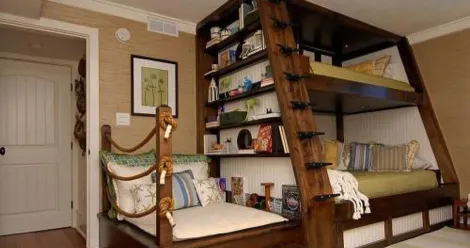
Bookshelves and Tips for Organising a Book Collection
Ah, the perennial problem: too many books and too little space. What to do when, once again, your bookshelves are full and not every book has a proper home? The topic of organising a book collection is one we’ve covered before (on unusual bookshelves, tips and steps on organising your collection, and ways to organise your books other than alphabetically), but given that this seems to be an ongoing dilemma, I thought it was a topic worth revisiting.
 The way I organise books depends a little bit on how the books were sourced. Library books sit on a shelf on my desk, and if it’s a large enough stack, I’ll organise it by DDC or alphabetically.
Books I borrow from other people will typically be in a similarly transient position. Books I own I will try to find a space for on my bookshelves. In our house, we have three bookshelves: two for non-fiction in the study, where books are organised by subject, and then one in the bedroom for fiction, where books are organised first be genre, then alphabetically by author surname, then publication date.
There is one more collection of books that I kind of order, and that’s my TBR pile. I typically have an ‘active’ stack of books I intend on reading within the next couple of weeks, and they’re the ones that sit on my bedside table. And then there are the ones that I want to read and definitely plan on it hopefully in the next year… Those are the ones that sit sideways on the bookshelf, in front of the collection that is already in their permanent home. They are separated out as a reminder to read them, and that I really should stop buying and borrowing new books when I have a TBR pile that’s out of control.
Other creative ways I’ve seen for ordering books include by height, or by colour, or by sentimental value of the book itself. Or even no order at all—as long as they’re on a shelf, that’s good enough. These ways of ordering books can lead to some beautiful displays, where the book as an object becomes art, such as in this example of books organised by colour. But then series get separated, and book-siblings (books by the same author) are not necessarily together, and I find that a little upsetting.
The way I organise books depends a little bit on how the books were sourced. Library books sit on a shelf on my desk, and if it’s a large enough stack, I’ll organise it by DDC or alphabetically.
Books I borrow from other people will typically be in a similarly transient position. Books I own I will try to find a space for on my bookshelves. In our house, we have three bookshelves: two for non-fiction in the study, where books are organised by subject, and then one in the bedroom for fiction, where books are organised first be genre, then alphabetically by author surname, then publication date.
There is one more collection of books that I kind of order, and that’s my TBR pile. I typically have an ‘active’ stack of books I intend on reading within the next couple of weeks, and they’re the ones that sit on my bedside table. And then there are the ones that I want to read and definitely plan on it hopefully in the next year… Those are the ones that sit sideways on the bookshelf, in front of the collection that is already in their permanent home. They are separated out as a reminder to read them, and that I really should stop buying and borrowing new books when I have a TBR pile that’s out of control.
Other creative ways I’ve seen for ordering books include by height, or by colour, or by sentimental value of the book itself. Or even no order at all—as long as they’re on a shelf, that’s good enough. These ways of ordering books can lead to some beautiful displays, where the book as an object becomes art, such as in this example of books organised by colour. But then series get separated, and book-siblings (books by the same author) are not necessarily together, and I find that a little upsetting.
Organising a Book collection
Historically, public libraries were established for the creation of an enlightened citizenry and for the purposes of disseminating and archiving knowledge. Contemporary libraries have shifted in focus and exhibit multiple functions and purposes, including leisure and entertainment. This is evident in not only the content of their collections, but also in the order and display of collections. This also speaks to issues of power and knowledge: the power inherent in curation and display of knowledge, and the ability to influence which books are borrowed and read. How do librarians decide which classification system to use? How easy is it for serendipitous discovery? The way books are shelved and displayed affect how readers can find them; a library is not simply a collection of books, but a collection of books ordered in such a way that items can be found. Even the most commonly used classification systems are not neutral: the Dewey Decimal Classification system was developed out of a particular historical and social context. The DDC was developed by Melvil Dewey in 1876, at a time and place where the aim of many educational institutions was to build character. At many New England colleges, character was built on a foundation of Protestant orthodoxy, Western culture and the classics. As a result, Dewey’s worldview was reflected in the classification system, where knowledge was absolute and the mind was seen as a vessel to be filled. Literary scholar Michelle Kelly suggests that the DDC can be seen as expandable literary theory which is shaped by theoretical assumptions that structure practice in scholarly pursuits. She asks, ‘Your book from 001.3 Humanities? The DDC has neighboured it. What do you think of its plan for the district?’ In personal collections, there are obviously fewer of these philosophical issues related to the organisation of knowledge, and the most pressing context in the organisation of our personal collections is probably the question of ‘Crap, I had another accident at the bookshop where I accidentally bought a lot of books. Where will I put them?’. Presumably, it’s only a handful of people who will be regularly reading from the collection (or maybe even just yourself). So how best to organise your collection, I think, depends on what kind of person you are. Are you the kind of person who likes things to be tidy and ordered, where every item has its place? Or do you thrive on chaos and organised disorganisation? What kind of reader are you? Do you have one spot where you regularly read, or do you read everywhere and therefore leave books everywhere? Do you have multiple rooms where books reside, like the bedroom for current reads, the study/library for the main collection, and the kitchen for cookbooks? Do you have enough bookshelf space, or is your home filled with haphazard stacks of books?
The books I borrowed from the library when I was working on the food industry post for Book Riot.











